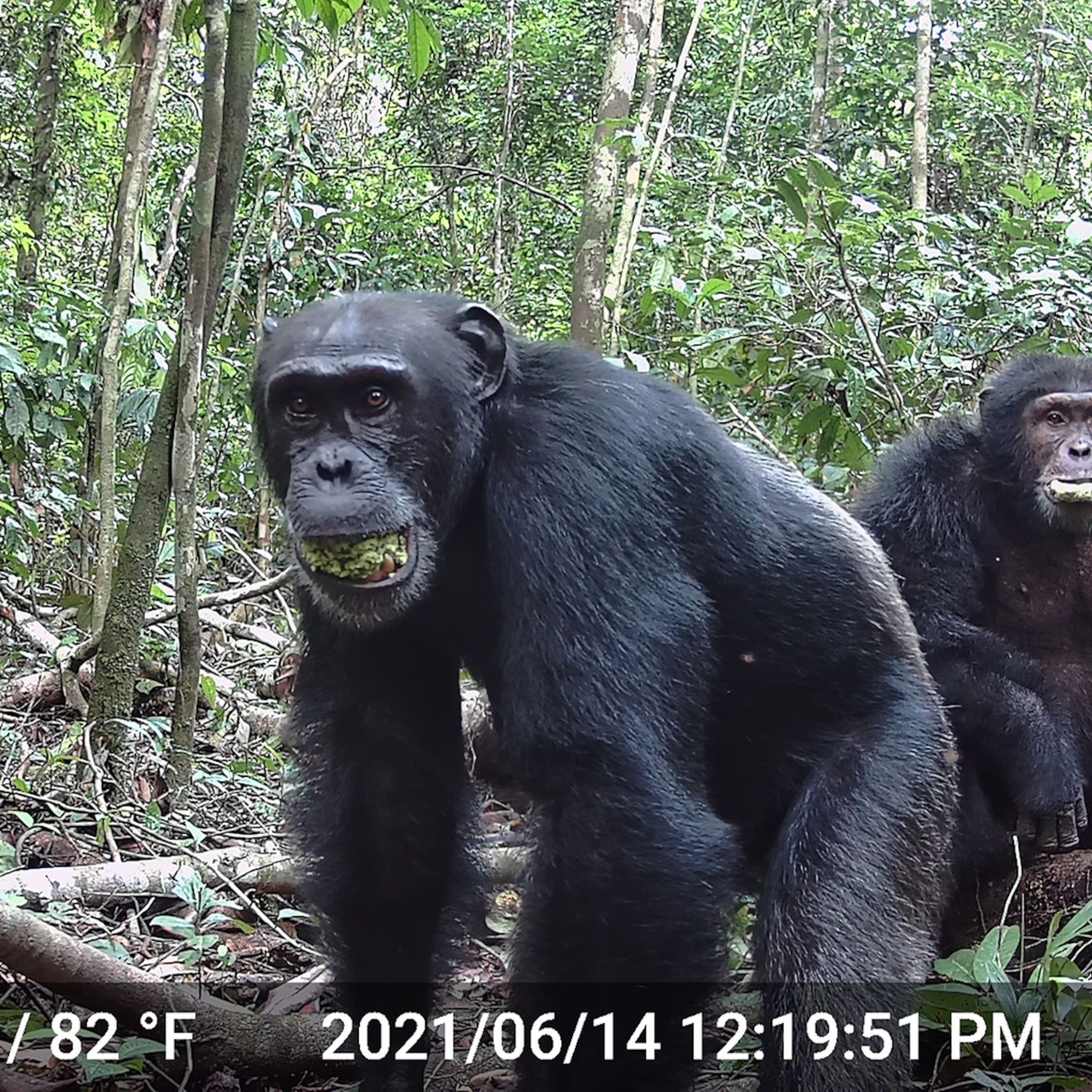Scientists now say that the simian immunodeficiency virus (SIV) in chimpanzees (Pan troglodytes), which is believed to have been transmitted to humans to become HIV-1—the virus that causes AIDS—didn't start its life in chimps.
Instead, it was a product of separate viruses jumping from different monkey species into chimps, where they recombined to form a hybrid virus, according to a new study.
Researchers believe the chimpanzee virus is a hybrid of the SIVs naturally infecting two different monkeys, the red-capped mangabey (Cercocebus torquatus) and the greater spot-nosed monkey (Cercopithecus nictitans). Chimps eat monkeys, which is likely how they acquired the monkey viruses. The hybrid virus then spread through the chimpanzee species, and was later transmitted to humans to become HIV-1.
The study suggests striking parallels between SIV infection of chimps and HIV infection of humans. Just as chimps acquired viruses from two different sources, humans are infected by two distinct AIDS viruses: HIV-1 and the less virulent HIV-2, which humans acquired from sooty mangabey monkeys.
"Because of the similarity between chimpanzees and humans, any virus that successfully adapts to spreading among chimps would be a candidate for a further jump to humans—a potential HIV-3," said Paul Sharp of the Institute of Genetics at University of Nottingham in England, who led the study.
The discovery also spotlights how many of our most virulent viruses were transmitted across species. The jumping of viruses from animals to humans occurs all the time. Diseases like SARS and monkeypox, which recently hit the northern United States, likely originated by cross-species transmissions.
"It seems this is happening more frequently because of two reasons," said Michael Lai, a virus expert at the University of Southern California, Los Angeles. "First, the detection of the virus is easier today because of advances in medical science. Second, international travel brings animals from far-away places to a new place."
From SIV to HIV
In 1999, the same team of scientists identified the origin of HIV-1 as being the transmission of a virus known as SIVcpz from chimpanzees to humans, but they didn't know how chimps acquired the virus in the first place.
SIVs are carried by many species of monkeys in Africa, but chimps are the only apes known to be naturally infected. While monkeys have been infected with SIVs for a long time, chimps apparently acquired the virus more recently.
The study shows that the SIVcpz strain arose in chimps through repeated transmission and recombination of SIVs from the red-capped mangabeys and greater spot-nosed monkeys. Chimps prey on both of these species and their ranges overlap in West and central Africa.
It is now widely accepted that humans contracted HIV from chimpanzees, probably by butchering them for bush meat. The new findings thus show that humans are not the only primate species to acquire two different immunodeficiency viruses by cross-species transmission.
The complexity of the HIV virus has increased through constant recombination. There are already many subtypes of the HIV-1 strain, and the diversity is growing. Even strains of the same subtype may now differ by up to 20 percent.
This knowledge is imperative in the quest for an AIDS vaccine. If a vaccine can be created, it's still unclear how much diversity it will be able to cope with.
Scientists say it will be important to examine whether chimpanzee predation on smaller monkeys has led to additional SIV acquisitions, and possibly coinfection and recombination with SIVcpz, and whether the resulting chimpanzee-adapted SIVs are more likely to infect humans.
"The major difference between SIV infection of chimpanzees and HIV infection of humans is that chimpanzees are not known to develop any disease symptoms," said Sharp. "Given the very close genetic relationship between chimpanzees and humans, this prompts the question whether chimpanzees have co-evolved with their virus to reach this non-pathogenic association."
Jumping and Recombining
Many, though not all, human viruses originated by cross-species transmission. On the list of viruses that have jumped from animals to humans are measles, influenza A, Ebola, HIV, SARS, dengue, and many others.
Some appeared in the last century; others emerged thousands of years ago and stayed. A few have always been with us, infecting our ancestors before they evolved to become humans.
"Almost all the human viruses have this kind of counterparts in animals, so they must have a common origin," said Lai.
The influenza A virus jumped into humans from birds, perhaps using pigs as a "mixing vessel," to create devastating pandemics in 1918, 1957, and 1968. Ebola hides in an (as yet unidentified) animal from where it jumps to humans. SIVcpz jumped from chimpanzees to humans at least three times.
"Advances in the ease of finding and characterizing viral genome sequences are having a major impact on our understanding of the diversity of human viruses and of their relatives infecting other species," said Sharp.
After jumping species, viruses can recombine with other viruses that have made the same jump, or with divergent strains already existing in the host, sometimes creating new hybrid viruses that may in some cases increase virulence.
Measles is one virus where recombination probably did not happen. Measles infections only last about two weeks, and generally there is only one strain common in a geographic area. So the opportunity for two viruses to meet may be limited.
Exotic Pets
Another virus that jumped species is monkeypox. Health officials in Wisconsin, Illinois, and Indiana recently reported the first outbreak of monkeypox in the Western Hemisphere. This is a rare viral disease that occurs primarily in the rain forests of central Africa.
The disease is called monkeypox because it was discovered in laboratory monkeys in 1958. Studies later showed evidence of infection in ground squirrels, which may be a natural host for the virus.
Infection with the virus results in a rash similar to smallpox, but less infectious. It's usually not fatal. Symptoms include fever, headache, muscle aches, backache, and swollen lymph nodes.
The people who became ill in northern United States reported close contact with ill prairie dogs. Health officials believe the prairie dogs contracted the monkeypox virus from infected Gambian giant rats, which were imported from Africa and housed in the same animal-holding facility as the prairie dogs.
"When we expose ourselves to exotic animals, there is always a risk of being exposed to something unknown," said Lai.
Scientists believe the encroachment by humans on nature also increases the spread of infectious diseases. The SIVcpz strain jumping from chimpanzees to humans likely occurred when humans hunted and butchered chimps for "bush meat," something humans have done for centuries.
Increased human populations have increased the chances of a virus successfully propagating among humans once it has made the jump. The SIVcpz strain was probably transmitted to humans in previous centuries, but never established a substantial enough transmission chain among humans to cause a large outbreak.
"When we perturb the existing peace between human beings and nature, we are opening a Pandora box, which may contain many surprises," said Lai.








